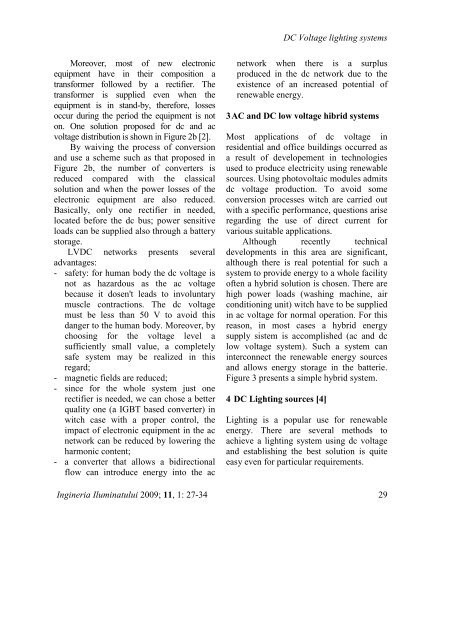ingineria iluminatului - Journal of Lighting Engineering - Prof. Florin ...
ingineria iluminatului - Journal of Lighting Engineering - Prof. Florin ...
ingineria iluminatului - Journal of Lighting Engineering - Prof. Florin ...
You also want an ePaper? Increase the reach of your titles
YUMPU automatically turns print PDFs into web optimized ePapers that Google loves.
Moreover, most <strong>of</strong> new electronic<br />
equipment have in their composition a<br />
transformer followed by a rectifier. The<br />
transformer is supplied even when the<br />
equipment is in stand-by, therefore, losses<br />
occur during the period the equipment is not<br />
on. One solution proposed for dc and ac<br />
voltage distribution is shown in Figure 2b [2].<br />
By waiving the process <strong>of</strong> conversion<br />
and use a scheme such as that proposed in<br />
Figure 2b, the number <strong>of</strong> converters is<br />
reduced compared with the classical<br />
solution and when the power losses <strong>of</strong> the<br />
electronic equipment are also reduced.<br />
Basically, only one rectifier in needed,<br />
located before the dc bus; power sensitive<br />
loads can be supplied also through a battery<br />
storage.<br />
LVDC networks presents several<br />
advantages:<br />
- safety: for human body the dc voltage is<br />
not as hazardous as the ac voltage<br />
because it dosen't leads to involuntary<br />
muscle contractions. The dc voltage<br />
must be less than 50 V to avoid this<br />
danger to the human body. Moreover, by<br />
choosing for the voltage level a<br />
sufficiently small value, a completely<br />
safe system may be realized in this<br />
regard;<br />
- magnetic fields are reduced;<br />
- since for the whole system just one<br />
rectifier is needed, we can chose a better<br />
quality one (a IGBT based converter) in<br />
witch case with a proper control, the<br />
impact <strong>of</strong> electronic equipment in the ac<br />
network can be reduced by lowering the<br />
harmonic content;<br />
- a converter that allows a bidirectional<br />
flow can introduce energy into the ac<br />
DC Voltage lighting systems<br />
network when there is a surplus<br />
produced in the dc network due to the<br />
existence <strong>of</strong> an increased potential <strong>of</strong><br />
renewable energy.<br />
3 AC and DC low voltage hibrid systems<br />
Most applications <strong>of</strong> dc voltage in<br />
residential and <strong>of</strong>fice buildings occurred as<br />
a result <strong>of</strong> developement in technologies<br />
used to produce electricity using renewable<br />
sources. Using photovoltaic modules admits<br />
dc voltage production. To avoid some<br />
conversion processes witch are carried out<br />
with a specific performance, questions arise<br />
regarding the use <strong>of</strong> direct current for<br />
various suitable applications.<br />
Although recently technical<br />
developments in this area are significant,<br />
although there is real potential for such a<br />
system to provide energy to a whole facility<br />
<strong>of</strong>ten a hybrid solution is chosen. There are<br />
high power loads (washing machine, air<br />
conditioning unit) witch have to be supplied<br />
in ac voltage for normal operation. For this<br />
reason, in most cases a hybrid energy<br />
supply sistem is accomplished (ac and dc<br />
low voltage system). Such a system can<br />
interconnect the renewable energy sources<br />
and allows energy storage in the batterie.<br />
Figure 3 presents a simple hybrid system.<br />
4 DC <strong>Lighting</strong> sources [4]<br />
<strong>Lighting</strong> is a popular use for renewable<br />
energy. There are several methods to<br />
achieve a lighting system using dc voltage<br />
and establishing the best solution is quite<br />
easy even for particular requirements.<br />
Ingineria Iluminatului 2009; 11, 1: 27-34 29
















